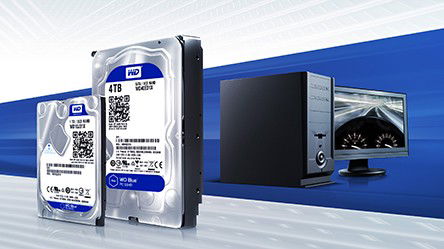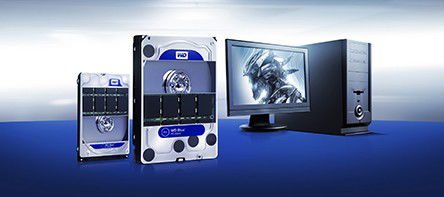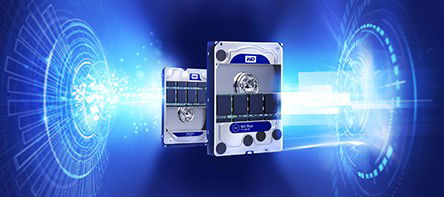Manufacturer: Western Digital
Price: RRP $184.99 (Western Digital Online Store Price, United States Region) / RRP $249 (Australian Region Pricing. Not available via WD Online Store ATM)
Available from: Western Digital Online Store or most Computer Parts Stores/Sites
Disclosure: The Western Digital Blue 4.0Tb SSHD was provided by Gap Marketing on behalf of Western Digital.
I’m not much of a tech reviewer as the speed at which computers are evolving is measured within the nanosecond range. When I was told that I should invest in a Solid State Drive or at minimum a Solid State Hybrid Drive, I just laughed it off as another piece of pointless tech jargon to sell new hard drives to the tech-crazy PC hardcore crowd. However, after spending some time with the Western Digital Blue 4.0Tb SSHD, I know I’m firmly in the wrong.
Now here’s a bunch of words and numbers that the tech-head will understand:
WD Blue SSHD Specifications
- Model number: WD40E31X
- Interface: SATA 6 GB/s
- Capacities: 4TB
- Form factor: 3.5-inch
- Advanced Format (AF)
- RoHS compliant
- Performance:
- Data transfer rate (max)
- Buffer to host: 6 GB/s
- Host to/from drive (sustained): 150 MB/s
- Data transfer rate (max)
- NAND Type: MLC
- NAND Size (GB): 8
- Cache (MB): 64
So what does that mean for the common computer user? To be honest it all translates into: This thing is FAST. Like Sonic 2 gotta go fast FAST.

Testing Time 1: As a storage drive
I performed 2 different tests with this hard drive. The first involved setting it up as a storage drive for two of my more used games: World of Warcraft & Final Fantasy XIV: A Realm Reborn Online. I also copied over a bunch of video files to view from the drive. The transfer, which clocked in at a bit over 100Gb worth of files, took a total time of 2 minutes and 50 seconds (timed via an external stopwatch app on my phone). Usually, the transfer of the same sizing of files to an external USB3.0 standard hard drive would take somewhere in the realm of 5 to 10 minutes. So overall, the process took a quarter of the time that it would to transfer to the external drive. Even my internal SATA 2.0Tb hard drive would take about 5 to 7 minutes to transfer these files.
The reason I decided on 2 MMO games to test the drive is that both games constantly write to a cache folder, with rewriting being something that happens as new areas and environments pop into the game. Plus the load times on these games is something I know I can measure without needing a hyper-powerful graphics card to handle most of the work. The first thing I loaded up was World of Warcraft, which usually takes about 25 seconds to load up the launcher, then between the launcher and the game is 1 minute easily; with the Western Digital Blue, it was an instant thing. Launcher booted up in 2 seconds and from going to the launcher to the game took 2 seconds also. Which, to me, is a big difference when I need to reboot the game due to a disconnection.
With videos, they loaded with no time needed. Usually, there is a few seconds, usually about 5 or so, between change over from video to video. With the Western Digital Blue, it was no time at all. Even leaving the video paused so Windows could do it’s usual suspend mode with the drive, it took no time at all for it to go right back to playing… Plus the drive was whisper quiet in resuming, unlike my normal HDD, which you could hear an audible whirring as it powers back on.
Testing Time 2: As the main OS Drive
Ok, so the other way people use these types of drives is as the main drive, usually loading the Operating System of the PC onto it. I’m not a fan of using the Western Digital Blue as the main drive as it is a 4 Terabyte drive. I think the 1 Terabyte version would be more suited for the task, but I don’t have that on hand to use or I’d be using it instead; I’m sure the drive is more than good enough for the task.
Anyway, I loaded Windows 7 Professional onto the drive along with World of Warcraft, Skype, Audacity, Adobe Premiere Elements 10, and a couple of other more used programs onto it so I could go about my day to day operations during this testing phase. The load time going from cold boot to Windows was amazingly fast, only 30 seconds from bios to Windows fully loaded. Sure this might have been since I have only gone about 20% of the programs I usually have on the drive, but that’s still a good load time.
The major difference I found was when I started using the system for a couple of days. I noticed that while programs loaded with blazing speed from the get-go, as I used the same program more and more, the faster it would boot up than those I didn’t use as much. Since the main two programs I used were World of Warcraft and Skype, those moved into a priority setting as the drive learned what my habits were. Yes, you read that right, the drive learns your habits and will keep specific programs in its flash buffer for faster access. I have no idea what mystical voodoo magic Western Digital has inside this drive, but that’s an amazing thing to learn.
Testing Time 3: Video Processing
So every now and again, I do videos for my reviews or whatever; I’m sure you’ve seen them. Now with that comes the pain in the butt task of having to sit there and wait for the video to render and process. Well, those times are now so short that I don’t have time to go do something else while it processes. Due to the faster read/write nature of the drive, the Western Digital Blue cut those times in half easily. This is all due to the firmware being that of a Solid State Drive, which is all the rage with tech heads at the moment. I didn’t know how handy an 8Gb Flash buffer could be when doing my video projects. It’s so handy in fact that I dread running out of space and having to go back to my older mechanical hard drive. If it’s just for this fact alone, I recommend the Western Digital Blue to any creative types out there reading this review.

Western Digital Blue is one of those hard drives that is easily going to be overlooked by the tech nerds who always want the latest and greatest. So while they are dropping big dollars on their full-blown Solid State Drives that are not even pushing 1Tb yet, you should do yourself a favor and look into the Western Digital Blue range. Sure you’re going to be paying a bit more than your normal mechanical hard drive by about $50 (Australian Dollars) or so, but the investment is worth it. If you have the 1Tb WD Blue as your main OS drive, your system is going to run faster and your programs will load a lot quicker thanks to that WD voodoo they do so well. With the 4Tb model as your storage drive, you’ll be transferring files around so quickly that you’ll wonder how you filled up all 4Tb so fast. And to you creative types out there, trash that outdated mechanical crap and get an SSHD, trust me you won’t regret it.
Summary
Those tech guys might be preaching Solid State, but give me Solid State Hybrid anyday. Yeah you pay more for it, but it’s worth it. Faster loading for OS and programs, speedy read/write rates, and works so well that gamers will love it’s lag reduction too. Highly recommending you get one or more for your next PC build
-
Speed


